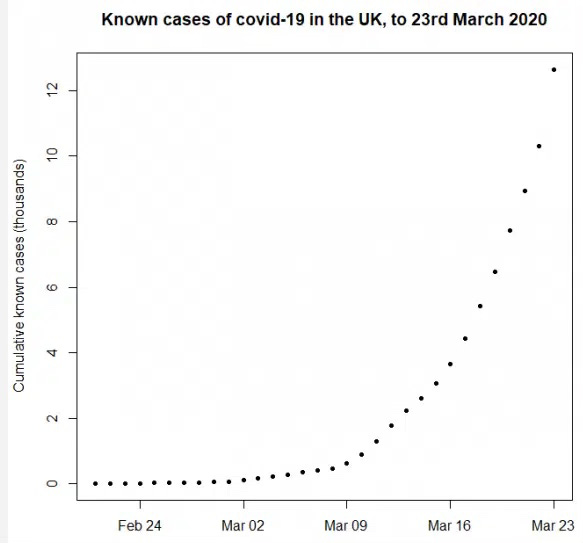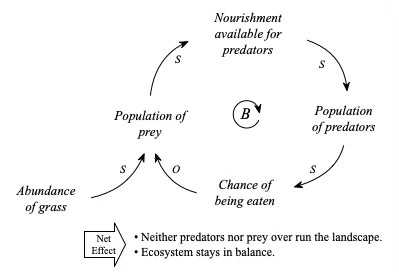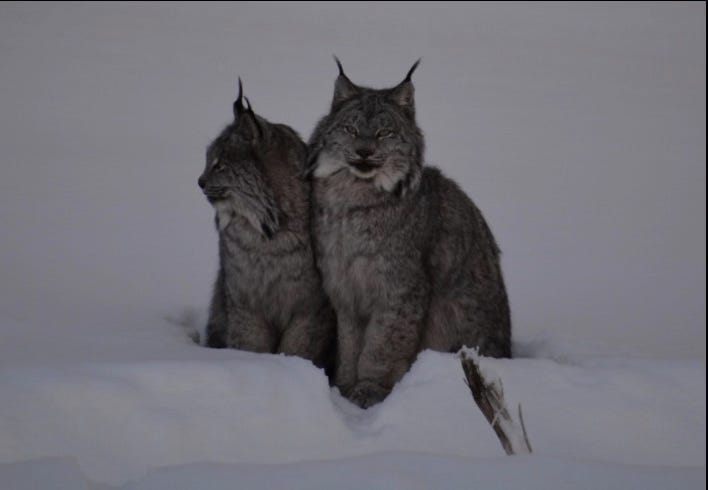The big picture:
A feedback loop is a system in which a change in something causes a change in something else, which in turn loops back around and causes a further change in the first thing, perhaps after intermediate steps.
Feedback loops make the world better. Because of feedback loops, neither predators nor prey species overrun the landscape in a well-functioning ecosystem. Via feedback loops, your body maintains its temperature and blood chemistry within a range that supports life. When you were born, a feedback loop enabled your mother to push. Your car is full of beneficial feedback loops, as is your kitchen, and your workplace.
But feedback loops can also change the world for the worse. Because of feedback loops, global climate change is happening faster than it would otherwise. Because of feedback loops, addiction can take over a person's life. Because of feedback loops, toxic memes race through society. The rich get richer and the poor get poorer, politics becomes more polarized and the middle class gets hollowed out.
Across all these cases the action of the loop in its entirety has an impact on the world that is more powerful than any of the isolated parts of the loop.
There are two main types of feedback loops: "reinforcing" feedback loops and "balancing" feedback loops. Here we introduce these two types of feedback loops with a classic example of each. We chose these particular examples because the models are fairly simple and the supporting empirical data are compelling.
"Reinforcing" feedback loops push aspects of the world towards more extreme situations.
In a reinforcing feedback loop, if something changes, that causes something else to change, which then causes the original thing to change even more. Over time, the system moves farther and farther away from its starting point. [Note: "reinforcing," "self-reinforcing," and "positive" feedback loop are synonyms.]
For example, the diagram below shows a simplified model of the initial spread of a contagious disease into a region where the people have no immunity. In this type of diagram, the words represent things that change. The arrows represent the way in which a change in one thing causes or tends to cause another thing to change.
If a traveler comes into the region carrying the disease, that nudges the Number of people in the region who have been exposed to the disease up from zero to some small number. Some of those exposed people catch the disease, which the model represents as an increase in Number of sick people in the region. Those sick people come in contact with others, which shows up in the model as a further increase in Number of people who have been exposed. That, in turns, causes a further increase in Number of sick people, and so on.
With each passage around the feedback loop, more and more people are exposed and more and more people get sick. Each passage around the feedback loop reinforces the initial nudge to the system instigated by that first traveler coming in from outside the region. Over time, the situation moves further and further away from how it was before that initial nudge.
A characteristic behavior of many reinforcing feedback loops is that the change speeds up over time, at least initially. The way this feels viscerally was expressed by Ernest Hemingway's character Mike in Then Sun Also Rises. When asked how he went bankrupt, Mike replied "first gradually, then suddenly."
For the Covid-19 pandemic, the number of cases was tracked by national health agencies, as shown in the graph below. The data show this same pattern of gradual change at first, and then more and more rapid change. You might recognize this as a pattern that mathematicians call exponential growth. Exponential growth is a common attribute of systems underlain by reinforcing feedback loops.

If you find yourself in a situation where something you care about has changed gradually and then faster and faster, consider the possibility that you might be experiencing a reinforcing feedback loop. In later posts, we will take up the question of how to disrupt or halt a feedback loop that you don't like.
Pandemic spread and bankruptcy are examples of reinforcing feedback loops with undesirable outcomes, popularly known as "vicious cycles." There can also be reinforcing feedback loops with desirable outcomes, like the interdisciplinary collaboration depicted in our substack header graphic. We hope that readership for our new substack will spread "virally," as early readers tell their friends and colleagues about our work, and those friends tell more friends. That would be a reinforcing feedback loop with desirable outcome, a "virtuous cycle."
Balancing feedback loops pull aspects of the world towards an equilibrium or goal state.
In a "balancing" feedback loop, when something changes, that causes something else to change, which in turn causes something else to change, which in turn loops back around and causes the first something to change in the opposite direction from the first nudge. Over time, a balancing feedback loop pulls the system back towards the status it had before the initial nudge or towards some kind of equilibrium or goal state. [Note: "balancing," "countervailing," and "negative" feedback loop are synonyms.]
For example: envision an island with one main predator species and one main prey species. A simplified feedback loop model for this situation is shown below. In a rich food year, the prey eat grass, and the predators eats the prey, and everyone is sufficiently nourished that they can live and reproduce successfully. If a drought occurs the grass withers; the prey go hungry; babies and weak individuals among the prey die. The Population of prey species is nudged downward. With fewer prey to eat, predators begin to go hungry. Babies and weak individuals among the predators die, and Population of predators goes down. But then, with fewer predators the Population of prey begins to come back up again. The sequence of influence began when the drought pushed the prey population downward; after one passage around the circuit of influences, the prey population moved upward. With subsequent passages around the loop, the prey population and predator population oscillate up and down, up and down, maintaining a rough equilibrium in the ratio of predators to prey. The net effect of multiple passes around the balancing feedback loop is that neither predators nor prey overrun the landscape.

It is hard to census populations of animals in the wild. Also, most predators and prey live in far more complicated situations, where there are multiple food sources and many factors that threaten the life span and reproductive success of animals. However, the expected oscillations can be seen in one of the clearest and longest data sets in all of ecology: records kept by the Hudson's Bay Company of the number of pelts that the company bought from trappers in the rich hunting grounds of northern Canada in the late 1800's and early 1900's. These painstakingly recorded numbers show a ten-year cycle in the number of pelts of snow shoe hares and a corresponding cycle in the number of Canadian lynx, as shown in the graph below.


This behavior of rising and falling around an equilibrium value is one of the characteristic behavior types of balancing feedback loops. So, if you find yourself in a situation where something starts to change, and then the world seems to conspire to pull the situation back again, consider the possibility that you may be experiencing a balancing feedback loop.
Balancing feedback loops can have desirable outcomes, as in an ecosystem where neither prey nor predator populations go extinct or overrun the landscape. But balancing feedback loops can also have undesirable outcomes, as when an individual's efforts to excel in school or workplace are countered by peer efforts to pull them back down.
About the diagrams:
Here is a short key to the diagrams in this substack:
• An arrow mean that we think that the entity at the upstream end of the arrow influences the entity at the downstream end of the arrow;
• An "S" on an arrow means that we think that the entities at the two ends of the arrow tend to change in the same direction. An "O" means that we think the entities at the two ends of the arrow tend to change in opposite directions. Some other loop diagram makers use "+" and "-" to convey the same meanings.
• An "R" in the middle of the diagram means that we think that the system is a Reinforcing feedback loop, whereas a "B" means that we think it is a Balancing loop. Some other loop diagram makers use "+" and "-" to convey these same meanings.
For more detail, please visit About Causal Loop Diagrams.
Sources and Resources:
• Ernest Hemingway, 1929, The Sun Also Rises, Charles Scribner's Sons. Quote is from p. 109 in the Scribner trade paperback of 2016. The novel tells us little of Mike's backstory. The "discarded first chapters," included as Appendix III in the Scribner paperback, tell us that Mike inherited fifteen thousand pounds from his father's estate (p. 274). The interpretation that he may have been caught up in a vicious cycle feedback loop is our own, although it is compatible with Mike's character.
• The graph of Covid growth graph comes from Stevens, R., Perera, R., Heneghan, C., Hobbs, R., & Oke, J. (2021). Exponential growth: what it is, why it matters, and how to spot it. Those authors cite as their data source the UKHSA Data Dashboard.
• The original source of the lynx/hare data was Elton, C. S. (1924). 'Fluctuations in the numbers of animals: their causes and effects.' Brit. J. Exp. Biol. 2: 119-63, refined by MacLuich, D. A. (1937). Fluctuations in numbers of the varying hare (Lepus americanus). University of Toronto Biol Series no 43: 1-136. The lynx pelt data was parsed into separate regions by Charles Elton and Mary Nicolson (1942). The ten-year cycle in numbers of the lynx in Canada, Journal of Animal Ecology, vol. 11, no. 2, p.215-244. The data in the graph are archived in the Hudson's Bay Company digital archives.
• The lynx photograph was taken by Kim Selbee and distributed via iNaturalist under a creative commons license.
• A five-minute Ted-Ed talk by Anje-Margriet Neutel provides a light-hearted but insightful introduction to feedback loops in ecosystems, using the Lynx/hare system as one of its examples: Feedback loops: How nature gets its rhythms. Note that this video uses "positive" and "negative" feedback loops for the concepts that this Substack calls "reinforcing" and "balancing" feedback loops.
• The dynamic in which an individual's efforts to excel in school or workplace are countered by peer efforts to pull them back down is known as the "tall poppy syndrome" in English, and there are analogous idioms in other languages; read more here.

